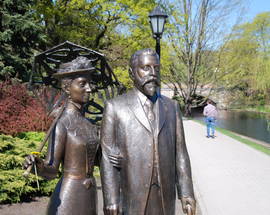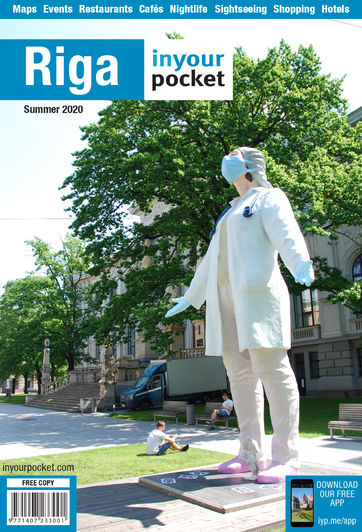Riga's Unlikeliest Statues
more than a year agoMirzo Ulugbek (AKA Ulugh Beg)
The ruler of vast swathes of Central Asia including parts of present-day Afghanistan, Kyrgyzstan, Tajikistan, Turkmenistan and Uzbekistan and grandson of the (in)famous Timur (or Tamerlane), Ulugh Beg (1394 - 1449) was also a famous mathematician and astronomer in his day. In fact, he built the Islamic world’s largest observatory in Samarkand. Today you can take a gander at his fierce, yet learned visage on the left bank of the Riga canal near the pedestrian bridge in the Kronvalds Park. The bronze statue on a red granite pedestal was a gift from the Embassy of Uzbekistan.
Mr. & Mrs. George Armitstead (and dog)
Although the British are perhaps better known in Riga as the loud lads wearing outrageous costumes who insist on observing their nostalgic custom of getting completely wasted by 23:00 (note: pubs are open quite late in Riga, especially at the weekend), one Brit in particular has left a good and lasting impression on the city’s inhabitants. George Armitstead (1847 - 1912) was born in Riga and after studying abroad in Switzerland and even Oxford, he eventually returned to Riga where his wealthy family owned businesses and properties. He was elected mayor of Riga in 1901 and presided over an unparalleled period of construction, reform and prosperity until shortly before his death in 1912, when he was finally awarded honorary citizenship of the city he transformed. A bronze statue of Armitstead, his wife Cecile and their dog was unveiled by Queen Elizabeth II in the Latvian National Opera gardens in 2006.
Prince Michael Andreas Barclay de Tolly
The man with the poshest and most foreign-sounding of possible names was actually a German-speaking descendant of a Scottish family that settled in the Baltic region of what was then the Russian Empire. Although he was born in present-day Lithuania he was raised farther north in parts of Latvia and Estonia, which were then known as Livonia. He distinguished himself as an officer in the Russian army and fought in battles all over Europe, most famously as the Commander-in-Chief of the largest Russian army tasked with defending the homeland from Napoleon. He was eventually sacked, but then distinguished himself again at the Battle of Borodino and later commanded the forces that occupied Paris in 1814. He was made a field marshal and finally, a prince in 1815. Barclay de Tolly (1757 - 1818) was honoured with a statue in the Esplanade Park (just opposite the Radisson Blu Hotel Latvija) in 1913, but the original bronze monument was lost at sea when the city was plundered two years later. A new bronze statue was erected on the original granite pedestal in 2001.
/riga/prince-michael-andreas-barclay-de-tolly-statue_144628v
The man with the poshest and most foreign-sounding of possible names was actually a German-speaking descendant of a Scottish family that settled in the Baltic …








Comments